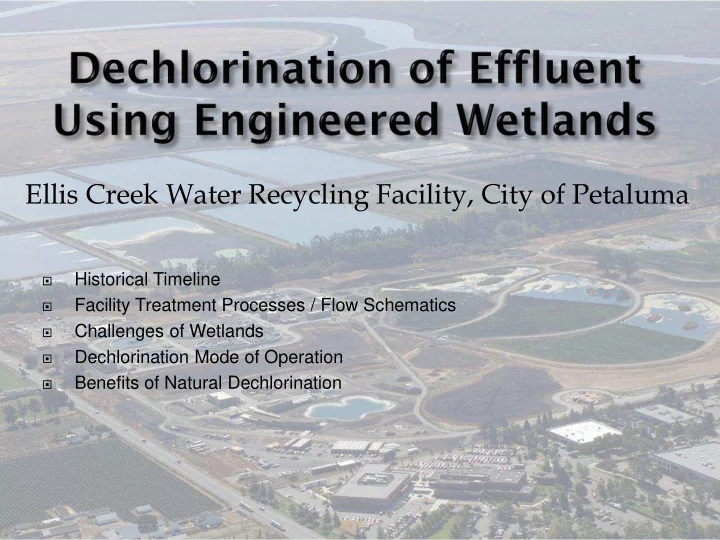

Ellis Creek Water Recycling Facility, City of Petaluma Historical Timeline Facility Treatment Processes / Flow Schematics Challenges of Wetlands Dechlorination Mode of Operation Benefits of Natural Dechlorination
1938: Original Plant Oct 2005: Construction Built on Hopper St. Contract Awarded 1972: Oxidation Ponds Jan 2009: Plant Built Operational Late 70’s / early 80’s: Prohibition of summer discharge & start of agricultural reuse 2002: Ellis Creek WRF @ 50% Design 2004: Purchase 261 Acres for New Plant
Cl2 Oxidation Treatment Polishing Ponds Wetlands Wetlands Pond and Wet Weather Bypass Secondary Clarifiers River Discharge Bar Vortex Influent Hypochlorite/ Bisulfite Oxidation Screens Grit Flow Disinfection Ditch Removal Meter T ertiary UV T ertiary Flocculation Filtration Disinfection Pump Station RAS Unrestricted Reuse WAS Gravity Belt Disposal Anaerobic Screw Pet403F1-6069.cdr Thickener Digester Press Dewatering
Design Criteria ADWF 6.7 mgd, Peak Flow 36 mgd INF BOD 275 mg/L; INF TSS 275 mg/L 18,600 lbs/day BOD loading to Orbals Secondary Treatment Process Activated Sludge – Siemens Orbal Process (<16mgd) Aerated Lagoon/Oxidation Ponds (>16mgd) Advanced Secondary Treatment Process Treatment Wetlands (30 acres) Re-purposed two existing storage ponds Polishing Wetlands (31 acres) Anaerobic Digestion of Waste Activated Sludge Tertiary Treatment Continuous Upflow Sand Filters UV Disinfection Users: City Parks, Golf Courses, Vineyards, Pasture Irrigation
Algae removal Enhanced secondary treatment metals and nutrients Reduced energy & chemical costs versus DAFT Conservation of 200 acres of wetland/upland habitat along Petaluma River Integration of 4 miles of recreational trails Recreational activities; bird watching, hiking… Educational opportunities including interpretive signage
Presence of Endangered Species California red-legged frog California clapper rail Salt marsh harvest mouse Wetlands are an Ideal Mosquito Habitat MSMVCD – manages mosquito abatement program Vegetation Management
Pond 7: Gate Closed JB1: Gate Closed Gate 10: Closed Gate 11: Closed Gate003: Auto/Remote Gate002: Auto/Remote Gate001: Remote (Auto/Manual)
CCB Mode of Operation: Use chlorine contact chamber followed by chemical dechlorination Sodium bisulfite used to dechlorinate final effluent Continuous monitoring of chlorine residual Natural De-chlorination Mode: Chlorinate between Treatment Wetlands and Polishing Wetlands followed by natural de- chlorination Naturally dechlorinate through Polishing Wetlands Monitor chlorine residual 2x/day Use CCB mode and natural dechlorination mode in parallel operation Sodium bisulfite used to dechlorinate Continuous monitoring of chlorine residual
Testing has shown no chlorine is present at the vegetative/open water interface in first series of Polishing Ponds Prove a 0.0 mg/L chlorine residual by dosing bisulfite, and by titrating a negative chlorine residual (bisulfite residual) Compliance location is E-001 NPDES permit requires two chlorine titrations per day, minimum 4 hours apart. Target residual 1.5 – 2.0 mg/L SCADA will log a “99” in the historian to indicate the DeOx 2000 analyzers are disabled in Wetlands Mode Flow paced dosing of sodium bisulfite, residual control is not available
Reduced bisulfite costs (approx 75%) Reduced reliance on chemicals Reduced staff time maintaining DeOx 2000 analyzers Reduced call-outs & alarms for dechlorination system Eliminated the potential for chlorine violations Reduce operational stress
Optimized existing infrastructure Reduced operating costs Improved operational reliability Maintained treatment performance Maintained recreational and educational opportunities for the public
Recommend
More recommend